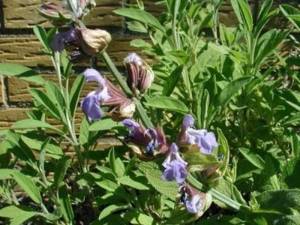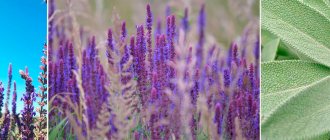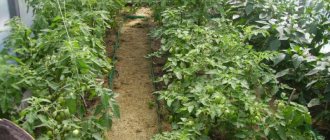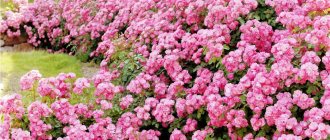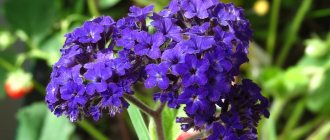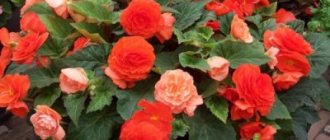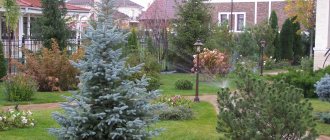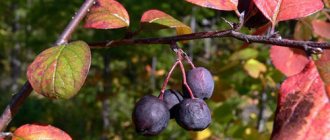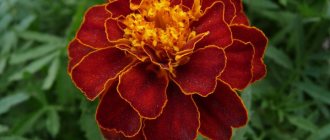Bee sage
Pigeon sage (S. columbariae)
An annual plant from the southwestern regions of North America.
Like Spanish sage (S. hispanica), widely cultivated by the Aztecs as a staple food before the Spanish colonized the Americas, this plant produces tiny seeds very rich in omega-3 fatty acids, antioxidants, vitamins, minerals and fiber. Related article:
Crassula is a real home healer
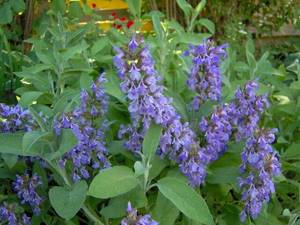
Sage pigeon
Diviner's sage (S. divinorum)
The variety exists only in culture and was used for many centuries by Mexican Mazatec shamans as a means of inducing prophetic visions and promoting spiritual cleansing. Despite the hype surrounding it, this plant has nothing in common with either LSD or cocaine.
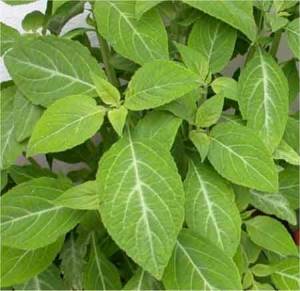
Sage Diviners
According to doctors, it does not cause pathological dependence and does not have toxic properties. But in Australia, South Korea, Belgium, Italy and Denmark, this “weed” is prohibited.
Species with fragrant foliage. Some of these plants are used in cooking. Pineapple sage, which has narrow clusters of red flowers and pineapple-scented leaves, is often used to flavor drinks and as a seasoning for desserts.
Related article:
The benefits and harms of rose hips for the health of the body
One variety of this sage (Honey Melon) smells like cantaloupe, while Doris sage (S. dorisiana), with its large, lush clusters of pink flowers and wide leaves, smells of peach and other fruits. Cleveland sage (S. clevelandii), which grows in California, also has very fragrant leaves.
Apple sage (S. pomifera) is found on several Greek islands. Local residents candy the translucent galls that form on its leaves and eat them as a sweet.
Spreading
Various species of sage grow naturally in tropical and temperate regions of almost the entire world. The only exceptions are Australia and the Far North. In America alone there are about five hundred species of sage. Photos of the plant can be seen in all reference books and manuals for naturalists.
Under natural conditions, the plant prefers sunny places - rocky slopes, light forests, flooded and dry meadows, wastelands.
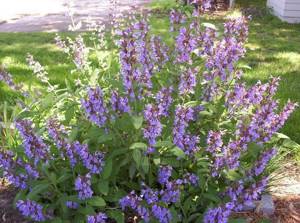
Sage: types and varieties
The huge sage family unites so many decorative species that it is quite possible to create a variety of decorative herbaceous carpet options even for experienced gardeners. An amazing plant - sage. The types and differences between them allow you to choose a plant in accordance with your preferences: some are distinguished by bright flowering, others create a durable and also fragrant carpet, and others have a delicious taste.
Fast-growing, unpretentious and low-maintenance, sage is an excellent partner for many decorative foliage and flowering plants. Most types of sage, photos of which can be found not only in manuals for herbalists, but also on landscape design, have healing properties to one degree or another.
Infusions and decoctions of sage are used to treat infertility, colds and viral diseases. In addition, medicinal preparations based on this plant are effective for a number of skin diseases, endocrine and neurological problems.
Content
- General information
- Sage types photos and names
- Sage planting and care in open ground
- Watering sage
- Soil for sage
- Replanting sage
- Fertilizer for sage
- Sage bloom
- Pruning sage
- Sage preparation for winter
- Sage propagation
- Sage growing from seeds
- Diseases and pests
- Sage medicinal properties and contraindications
- Sage decoctions
- Sage infusions
- Conclusion
Salvia officinalis
The types of Salvia officinalis, photos of which are available in the article, were most widely represented in southeastern Europe - Yugoslavia and Albania, Greece and Italy. Over time, they spread throughout European territory, and even later throughout the world. The leaves of this sage contain essential oil rich in pinene, thujone, alkaloids, D-camphor, flavonoids and tannins.
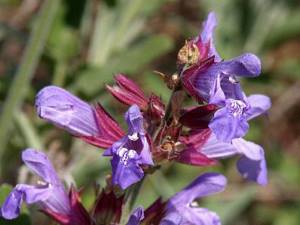
The fruits of this type of sage contain essential oil containing glycerides and linoleic acid. Different types of medicinal sage are most common in our country. Sometimes it is also called garden.
Diseases
Sage is a medicinal plant and is therefore considered an excellent insecticide. However, it is susceptible to some diseases.
Therefore, you need to take certain actions to save the flower after detecting signs of disease.

1- Root rot 2- Rust
| Disease | Short description |
| Rust | Dense brown teliosoruses appear on the underside of the leaf. The leaves begin to turn yellow and fall off. It is necessary to remove the affected areas so that the flower does not die. |
| Black root rot | The roots become covered with plaque and gradually turn brown. If the damage is severe, the plant dies. Fungicides must be used to control the fungus. |
| Root rot | The lower part of the stem darkens, rot and plaque gradually appear. It is possible to combat this disease with fungicide solutions. |
Interestingly, parasites rarely infect sage. If for some reason they decide to feast on it, then they will leave after a while. You don't have to do anything special.
Thus, sage is an excellent perennial plant that can delight with its inflorescences for up to 8 years in the southern regions. In other regions of the country, it is used for no more than two years, after which a new one is planted. It is possible to plant it as seedlings, but it is better to immediately plant it in open ground. With proper care, sage will produce large and beautiful buds that will bloom for quite a long time.
External features
The plant is about eighty centimeters high, with a straight, tetrahedral or rounded stem, branched and pubescent at the top. The leaves are gray-green in color, with whitish fibers. They are elongated in shape - from lanceolate to ovoid, up to ten centimeters long. The upper leaves are located on petioles, and the upper ones are without them. There are cold-resistant varieties:
- Aurea with creamy green leaves.
- Purpurascens with burgundy-green.
- Cterina with golden-yellow leaves interspersed with green.
- Tricolor with cream-burgundy leaves.
At the beginning of summer, light purple flowers appear. Flowering continues throughout the summer. Sage is cross pollinated. The fruits of the plant are small brown nuts, about three millimeters in diameter.
Sage: growing seedlings and care
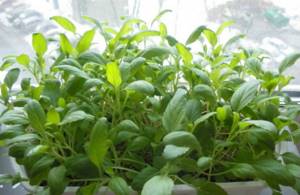
Overgrown salvia seedlings are difficult to pick: the stems become thin and break easily
The flower needs 8-10 hours of abundant lighting. Especially in the morning and evening. Even on a south-facing window, seedlings suffer from a lack of sun and need artificial lighting.
Advice. If the sage seedlings stretch out a lot, it’s not a problem. Try cutting the stems and placing them in water (you can add Kornevin). There is a good chance that they will soon acquire their own roots.
It is better to water through a tray so that the roots do not suffer from waterlogging.
If the salvia has come up in a thick brush, pull through. It is important that each seedling has a feeding area of at least 5 square centimeters. Or, in the phase of two true sheets, they make a pick - they seat the kids in separate cups.
Video on how to properly pick sage seedlings:
At a young age, sage is very sensitive to cold and draft winds. At temperatures below +20 degrees, growth stops, and at +15 degrees, the leaves begin to droop.
The secret secret to getting a spreading bush is early pinching. If this is not done, the plant will become long and bloom prematurely. However, you will not achieve volume and beautiful shape.
The top is usually removed above the 6th leaf or when seedlings from seeds stretch to 8-10 centimeters. By the way, the cut part can also be easily rooted in water and then transferred to a pot.
Elegant sage
A variety of medicinal sage. This plant is up to a meter high with funnel-shaped red flowers that appear on the branches in late summer. If you rub the leaves of this type of sage between your palms, you will notice a fruity smell. This plant has found application in cooking, for example in fruit salads. The most popular varieties: Scarlet Pineapple, Tangerine Sage.
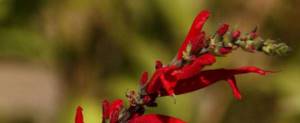
Clary sage
Some types of sage, descriptions of which can be found in herbal medicine reference books, have exclusively medicinal properties. For example, clary sage has been used in medicine for a very long time. It is also grown for its essential oils. Today, such types of clary sage as Voznesensky 24, Crimean early and late are popular.
This plant can also be classified as an ornamental sage species (we posted the photo in this article) due to its compact size. This biennial plant does not exceed forty centimeters in height. Clary sage grows naturally in Central Asia, the Caucasus, and Europe, and is cultivated everywhere.
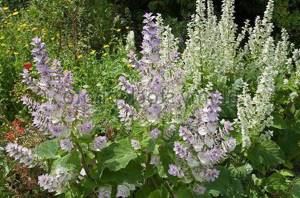
This variety is also grown to produce such a valuable product as sage oil. Sage grows mainly on sand, arable land, clay and rocky soils. The roots of this species contain coumarins, and the inflorescences and leaves contain aromatic resins. The plant has powerful antibacterial properties, and its roots, according to healers, prevent the development of tumors in the body.
Seedling care
Sage loves nutritious and breathable soil; before planting, it is necessary to add humus, compost, river sand to the soil; it is used to loosen the soil. Before planting a plant in the soil, it needs to choose the right place: it is recommended to plant it where cabbage, potatoes and beans grew.
We recommend that you read the Abstract on the use of sage bronchoactive
Care consists of the following:
- Water moderately so that water does not accumulate in the soil, loosen the soil in a timely manner.
- Do not allow weeds to spread in large numbers, as they will cause various diseases to appear on the plant and will also suppress its growth.
- Regular feeding, first requires nitrogen, then organic fertilizers. It is recommended to fertilize with wood ash, which contains a large amount of microelements.
- In winter, sage is covered with leaves that have fallen from the trees to protect it from frost.
- In autumn or early spring, pruning is required for abundant flowering; after flowering, the sage is mowed with a scythe almost to ground level.
- You can replant the plant for its normal growth and flowering.
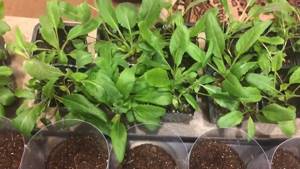
Due to the content of a large amount of essential oils, the plant rarely gets sick. The only vulnerable spot is the root system, which is damaged by heavy watering or frequent rains. If mold appears, it is recommended to treat it with a sulfur solution, strictly following the instructions. The most dangerous pests are thrips, spider mites, and slugs.
Perennial types of sage: photo, description
Despite the fact that this is a heat-loving plant, some of its varieties tolerate winter frosts quite well. These include meadow and oak forest species.
Meadow sage
The plant is distributed throughout Europe. This type of sage prefers to settle on grassy and rocky slopes. In folk medicine, meadow sage is used in the form of tea and infusions for scrofula, ringworm, diseases of the gastrointestinal tract, and scabies. In addition, infusions are effective for diseases of the respiratory tract, as well as when applied externally in the form of compresses, as well as rinses for periodontal disease, stomatitis, and sore throat.
Meadow sage essential oil has an antimycotic effect. It has found application in cosmetology and perfumery. Salvia pratensis is much more aromatic than the medicinal one. Young leaves have an astringent taste, while older leaves have a bitter taste. For harvesting and drying, young shoots are cut before flowering begins. Popular varieties are Superba, Sensation White. The plant tolerates summer heat well, losing its bitterness. It is added to various dishes, mainly fish and veal.
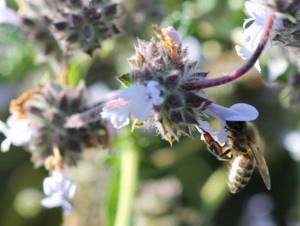
Oak sage
This variety of sage is found in the European part of our country, in Central Europe, in the foothills of the Crimea. The plant prefers forest edges, dry meadows and steppe slopes. Oak sage contains phytoncides, mineral salts, essential oils and tannins. It blooms from late June to September.
This type of sage, a photo of which can be seen in gardening reference books, has wrinkled leaves, the size of which decreases from bottom to top. The plant is represented in our country by many varieties, differing from each other in the shades of inflorescences (lilac, purple, blue), flowering time, and the size of the bushes. The most common varieties are Schwellenburg, Caradonna, Adrian, Schneehugel, Marcus, Plumosa.
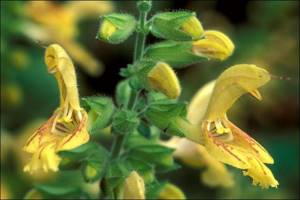
Sage Diviners
In nature, there are also species of sage that are prohibited for cultivation in our country. You can see a photo of the Salvia divinorum plant below. This variety does not have any fundamental differences in structure from other representatives of its genus. It is a perennial rhizome, at the beginning of development it is herbaceous, and later it is a subshrub plant.
Under natural conditions it grows in the subtropics throughout the year. This is a rather rare species in its family, most widely represented in the inaccessible mountainous regions of Mexico. For a long time, fortune teller sage has been used by the indigenous inhabitants of the country - the Mazatec Indians - for ritual rites and predictions.
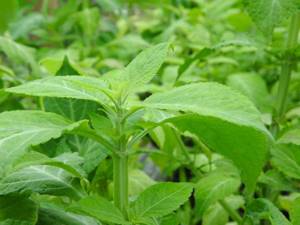
The thing is that the leaves of this plant contain the strongest hallucinogen - salvinorin A, for this reason, today, lovers of narcotic mixtures smoke predictor sage. That is why the plant is prohibited from growing in our country.
Decorative sage
Types of decorative sage are actively used in landscaping dacha and garden plots, areas of country houses, parks and squares. Glossy sage looks impressive in flower beds and garden beds. Compact varieties can be planted on balconies in pots and containers; they are used in mixed compositions to create bright spots. These plants are decorative throughout the season.
Ethiopian sage
This shrub is perfect for planting against a background of stones. Its large and beautiful rosettes with pubescent leaves in the first year and huge airy inflorescences in the second are unusually impressive.
Compact sage
Salvia Yurisich and dandelion - look great in mixborders in the foreground and in rockeries. Sage is practically not used for cutting, but the exception in this sense is mealy sage. Its velvety dark blue inflorescences in a vase remain decorative for a long time, and when dried they are an interesting material for creating winter bouquets. For the same purpose, faded whorled sage of the Purple Rain variety with very beautiful purple cups and green sage are suitable.
In the article, many types of sage were presented to you. Photos and descriptions will help you choose the right variety to grow in your garden or summer cottage. In addition to the species that we have talked about, in natural conditions there are: green (variegated) and red, dove and golden, mountain silver and Remera, etc. Moreover, each type of plant also has dozens of varieties. And now it’s time to talk about what healing properties this plant has.
Sage varieties
Drug
- The essence of the plant is contained in its name. This is a perennial crop reaching a height of up to 1 m.
- Its homeland is Asia Minor and the Mediterranean.
- The leaves of this species are oblong and wrinkled, they have disinfectant and anti-inflammatory properties.
- The inflorescences contain blue-violet flowers.
- The stems are branched below, flowering occurs in June-July
Varieties: Breeze, Aibolit, Nectar, Patriarchal Semko, Kubanets, Kew Gold, Aurea, Tricolor, Icterina.
White sage
- It has leaves that exude a pleasant aroma and white flowers.
- It is also called honey plant, due to the active substances contained in honey. E
- It is used to disinfect the oral cavity, to maintain fresh breath and good health.
Forest
- It is also called oak sage.
- This perennial plant has a straight branching stem reaching a height of up to 70 cm.
- Forest sage has large inflorescences consisting of small purple flowers that exude a subtle, pleasant aroma.
- Flowering occurs between June and September.
Lugovoy
This variety is called the grass of immortality. It is used for antiseptic, anti-inflammatory and expectorant purposes in the form of tinctures and decoctions.
Muscat
- It got its name thanks to German winemakers, for whom the taste of sage resembled the taste of muscat wine.
- Beneficial essential oils are obtained from this type of sage.
- The culture is widely used in the food industry and pharmacology.
- The plant is resistant to frost and drought.
- Due to its interesting bush shape and rich aroma, it is popular for growing in gardens.
- Young leaves are used both dried and fresh. The blanks are collected in a bundle and hung in a dry place, avoiding direct sunlight. You can also dry it on paper, and the plants are stored in rag bags or glass containers.
Varieties: Voznesensky 24, S-785, Moldavsky 404, Krymsky early, Moldavsky 69, Krymsky late.
Perovskia Russian
- Named in honor of the governor of the Orengbur province Petrovsky V.A.
- This durable plant is easy to care for.
- It differs from other types of sage in its long flowering period.
- It grows in the form of small bushes reaching a height of 1 m.
- It has elongated, dissected leaves.
- The inflorescences consist of small blue-purple flowers.
Leaves
Sage leaves contain:
- alkaloids;
- tannins;
- essential oils.
In folk, as well as in traditional medicine, tinctures and infusions of plant leaves are used in the treatment of diseases of the oral cavity, larynx, and pharynx. In addition, due to the large amount of vitamins and active substances in them, the leaves have astringent, anti-inflammatory and antimicrobial properties. Sage leaves reduce sweating and improve the functioning of the gastrointestinal tract.
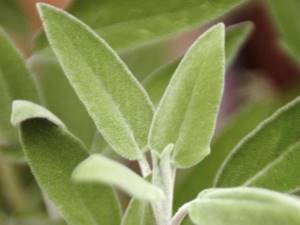
Medicines based on sage: infusion
To prepare the infusion, you will need one part of dry raw materials, which is poured with ten parts of boiled warm water. You can take one part of fresh, previously well washed and crushed leaves and fill them with five parts of water. The leaves must be infused for at least two hours. This composition can be used as a disinfectant and anti-inflammatory agent for lotions, rinses, compresses, etc.
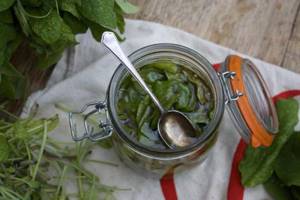
Sage decoctions
Sage decoctions are taken as an effective therapeutic agent for many diseases, and are also used in cosmetology.
First of all, sage is a feminine herb that allows the fair sex to maintain youth and beauty. Decoctions are taken for infertility, menopause and hormonal imbalances.
In addition, sage is used in the treatment of skin diseases, gastrointestinal ailments, urinary system and others. The decoction is used for hair and facial skin.
Decoction for strengthening hair
To prepare a decoction for rinsing hair, you should take fresh, finely chopped leaf plates along with inflorescences in the amount of one glass and pour a liter of boiling water over them.
After this, the broth should be left for 30 minutes, filtered and used as a rinse after washing your hair for a month.
Decoction for the face
Most often, sage infusion is used as a tonic for oily skin. To prepare it you need to take 1 tbsp. spoon of dry raw materials and pour 100 milliliters of boiling water over it.
After the broth has cooled, it should be mixed with a teaspoon of vinegar, poured into a bottle and put in the refrigerator. The resulting mixture must be used within a week after waking up.
Decoction for conceiving a child
Sage decoction can also be taken by women who want to become pregnant. To prepare it you need to take 1 tbsp. spoon of sage seeds and pour a liter of boiling water over them.
Then the broth should be left until it cools completely, strain and take 1 tbsp. spoon twice a day after the cessation of menstruation for eleven days. If conception does not occur, the course is repeated three times.

Decoction
To prepare this remedy, pour 200 ml of water into a tablespoon (tablespoon) of dry leaves and place the container in a water bath for twenty minutes. You can prepare a sage decoction with red wine. This remedy has a beneficial effect on the kidneys and liver. The effect of sage will be further enhanced if wormwood herb is added to the decoction.
Decoctions are used to treat hypertension, atherosclerosis, and shaking palsy. For various diseases of the mouth and throat, rinsing with a decoction is recommended. You can forget about gum disease forever if you regularly rinse your mouth with a decoction of this plant at least once a day.

Sage oil
Has many medicinal properties. It reduces or completely eliminates pain, reduces lactation if necessary, raises low blood pressure, promotes faster tissue scarring and wound healing, and eliminates excessive sweating. The oil has antispasmodic, tonic, antimicrobial, antirheumatic, blood purifying, and diuretic effects.

It has found wide application in cosmetology. It is used to tighten pores and care for oily skin. It normalizes the balance of sebum secretion, stops hair loss, and gets rid of dandruff.
Contraindications to the use of sage
The use of sage for medicinal purposes is allowed only after consultation with a specialist, especially when it comes to taking drugs orally. We should not forget that treatment with sage is not a panacea for all diseases; the plant has quite a few contraindications, which include:
- individual intolerance to its individual components;
- pregnancy and breastfeeding;
- age up to five years;
- acute nephritis;
- diseases of the nervous system;
- hypothyroidism;
- uterine fibroids;
- polycystic ovary syndrome;
- endometriosis.
With long-term use of sage-based preparations, some disorders of the nervous system and irritation of the mucous membranes may occur.
Sage medicinal properties and contraindications
Only clary and medicinal sage have medicinal properties. The stem, flowers and leaves of sage are rich in essential oils, alkaloids, flavonoids, tannins, organic acids, glycerides, vitamins and minerals.
This medicinal plant is used for:
- Relief of inflammatory processes of the upper respiratory tract and nasopharynx;
- Disinfection and regeneration of the skin for burns, pustular diseases and frostbite;
- Restoring cellular structures of the liver and relieving inflammation in the gallbladder;
- Treatment of gastrointestinal diseases;
- Strengthening the immune system and increasing the body's energy reserves;
- Strengthening and improving hair growth, as well as improving blood supply to the scalp;
- Elimination of depression and regulation of central nervous system processes;
- Improving the functioning of the nervous system;
- Elimination of hyperhidrosis of the feet.
Sage is also included in many herbal remedies for the treatment of various ailments and is actively used in cosmetology.
Sage contraindications for use
Sage not only has benefits, but also harm. It should not be taken for more than three months, otherwise the accumulation of substances contained in the plant will negatively affect the functioning of the kidneys.
Sage-based products should not be taken by children, people suffering from polycystic kidney disease, pregnant or nursing mothers, if they do not want their milk to disappear. Hypotensive people and allergy sufferers should take sage with caution. In other cases, it is absolutely safe for the body and will not cause any side effects.
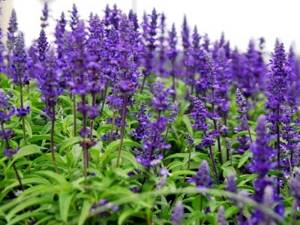
Growing a plant
Despite the variety of types of sage and the differences between them, there are requirements for cultivation that unite all varieties:
- plants develop more actively on light sandy loam soils;
- prefer normal soil acidity (pH 6.5);
- perennial species need shelter and spring pruning.
This plant can be grown in three ways: from seedlings, sowing seeds in the ground, or dividing bushes. If you want to grow sage at home, the seeds should first be soaked in Energen solution, which is a growth stimulant. To do this, dilute five drops of the drug in a quarter liter of water. Place the seeds in a cotton bag and soak in the solution for a day. After this, dry them a little and sow them in small separate containers, one seed at a time. Experienced gardeners recommend using peat pots.
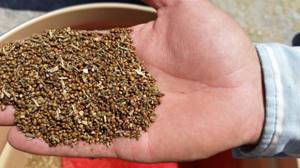
In spring, germinated seeds can be immediately sown in open ground. First dig up the selected area, make grooves and moisten them a little. Seeds are sown to a depth of no more than three centimeters. The distance between them is left about fifteen centimeters. If sage is planted in late autumn, dry seeds must be used. Although this plant is not demanding on the composition of the soil, gardeners note that it develops more actively on well-moistened and fertile soil.
Decorative species are photophilous. This should definitely be taken into account when choosing a landing site.
How to grow sage in the country?
Growing this crop is not a difficult task, which even a novice gardener can cope with. Sage will be a wonderful and effective decoration for your summer cottage, especially if you choose a place in the center of the front garden.
The soil for planting needs to be light and fertile, and the pH level should be 5.5-6.5. Sage requires sandy or rocky soil and is not recommended for planting in clay soil.
How to choose a place?
- This southern plant loves direct sunlight, under which its growth will be intense.
- The plant will also grow in shaded areas, but it will bloom profusely only in well-lit areas.
- It will be useful to plant sage in apiaries, since the plant is honey-bearing and attracts bees. Thanks to this proximity, the taste and medicinal characteristics of honey are improved.
Who should I plant next door to?
Sage gets along well with other plants:
- But it is definitely not recommended to plant it in a place where plants of the Yasnotkova genus previously grew.
- Due to the presence of a specific aroma that repels pests, gardeners often plant the plant near garden crops, but proximity to legumes, potatoes, cabbage and onions will have a more favorable effect on its flowering.
- It is not recommended to plant the plant after Lamiaceae crops.
Time to board
- The period from late March to mid-April will be favorable for growing.
- However, it can also be planted in May.
- In autumn, before wintering, sage is sown only in regions with a temperate climate.
How to grow sage from seeds and seedlings?
Regardless of the type of crop, it has the same growing season, flowering time and life cycle.
Planting sage is possible through seedlings or seeds:
Seedlings from seeds:
- favorable period: end of February - beginning of March;
- planting occurs in containers filled with a universal mixture;
- planting depth - 1 cm;
- Covered with glass, place the container in a lighted place;
- remove the glass as soon as the first shoots emerge;
- sunrises thin out;
- hardening of plants by taking them outside or to a well-ventilated place for 1.5 hours 10 days before moving them into open ground;
- planting in the flowerbed occurs at the end of May.
Sowing in open ground:
- It is recommended to plant from March to early April or, before wintering, in the fall;
- the soil is pre-fertilized with compost, humus or manure diluted in water;
- seeds are sown under film to a depth of 2 cm; in May, planting without shelter is possible;
- the distance between the rows is at least 50 cm, which can be reduced to 35-40 cm upon the appearance of the first sunrises;
- landing in one place is possible for 7-8 years in a row.
Plant propagation
Vegetative propagation also occurs:
- cuttings are carried out from late spring to early summer;
- preparation of cuttings in the form of a cut middle part of young plants or the top;
- The shoots are first rooted in the greenhouse for 2-3 weeks, after which they are planted in open ground;
- The division of the bush occurs in late summer and early autumn. To do this, the bush is dug out of the ground and its upper part is cut off with a shovel or knife. The root system must be treated with a fungicide.
- Covering with spruce branches or film for the winter is mandatory for young plants.
Care
Even a beginner in floriculture can take care of sage: the plant is undemanding in care. It only needs fairly infrequent watering, regular loosening of the soil around the bush, weeding and fertilizing. Every year, in early spring, organic fertilizers must be applied to the plant. Judging by the reviews of gardeners, liquid formulations are most suitable for this purpose - Agricola-Vegeta, Effekton-O.
In summer it is necessary to feed the bush twice. Sage can be grown in the same place for no more than six years. A plant older than four years should be rejuvenated. This procedure is usually carried out in early April. Shoots should be cut at a height of fifteen centimeters from the soil. This simple operation will make your plants more branchy and flowering more active.
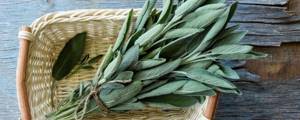
General information
There are about 700 species of this culture in nature. The plant's homeland is the Mediterranean, however, it is also common in our latitudes. Sage grows in the wild and in gardens as an ornamental and medicinal crop.
However, due to their low winter hardiness, ornamental varieties are grown as annuals, while medicinal sage can be grown for five years.
If a gardener sets himself the goal of decorating his plot with a beautiful and useful ornamental plant, sage will become for him the very crop that will transform his garden, giving it color and bright colors.
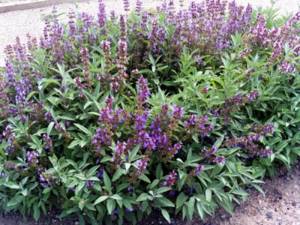
Collection of raw materials
Sage is harvested twice a season. The first collection takes place in early June. It is at this time that essential oil accumulates in the leaves. The second time sage is harvested is in September. The herb is dried in the open air, spreading it on a cloth or paper in a thin layer.
You can dry it in an oven or in an electric dryer at a temperature of +30-35 °C. At higher temperatures, essential oils evaporate. The raw materials retain their beneficial properties for one and a half years. The harvested grass should be stored in canvas or paper bags.
Sage propagation
Sage can be propagated using bush division, vegetatively, cuttings and seeds.
Dividing the bush should be done in the spring. After young shoots appear, the plant should be dug up and divided into several parts using a disinfected pruner, cutting the root system into parts with growth points. After this, the resulting cuttings need to be planted in the garden bed.
Vegetative propagation is carried out in early summer. To carry it out, you need to bend the shoot to the ground, secure it with a bracket and sprinkle it with earth. After two months, the shoot will have its own roots and then it can be separated from the adult plant.
To carry out cuttings, it is necessary to cut off a viable shoot with four buds. The leaf blades on the upper buds should be left, but on the fourth, the leaf blades should be removed and buried in the ground. The cuttings need to be rooted in a substrate of perlite and humus to a depth of 10 centimeters, inserting the shoot obliquely.
After this, the soil needs to be moistened and the container with the cuttings covered with film. The plant should be ventilated daily and moistened as needed. After a month, when the root system appears, the plant can be planted in open ground.
